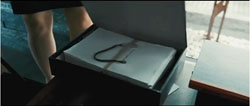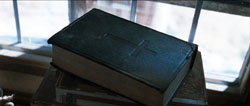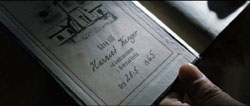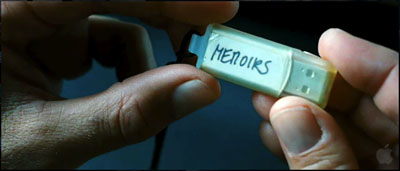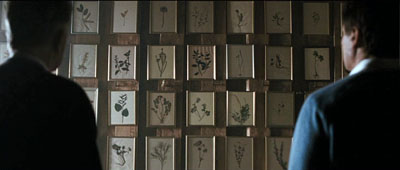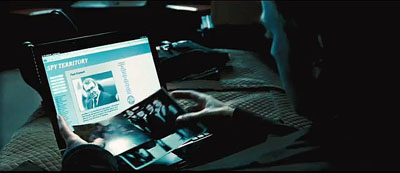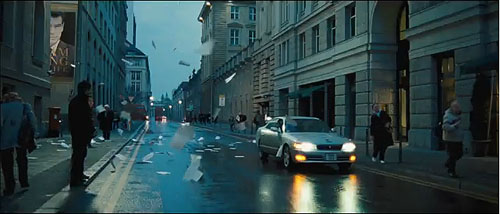The Ghost Writer (above); The Girl with the Dragon Tattoo (below).
DB here:
Aristotle said, quite reasonably, that every plot has a beginning, a middle, and an end. But that doesn’t mean that every plot consists of three acts. Aristotle doesn’t mention act divisions in the Poetics for the good reason that classical Greek plays didn’t have them. The three-act play is just one convention that emerged in the history of storytelling.
As early as 20 BCE Horace was suggesting, “Let no play be either shorter or longer than five acts.” Influenced by this edict, Renaissance editors and playwrights adhered to five acts for many years. We have, of course, plays in two acts (Alan Ayckbourn’s Norman Conquest cycle) and four acts (Pygmalion, The Admirable Crichton, many of Chekhov’s). TV dramas are routinely divided into a teaser and four acts, broken up by commercials. All of those plots have beginnings, middles, and ends, so it’s silly to think that only the three-act structure can fulfill Aristotle’s dictum.
As early as the seventeenth century, the Spanish playwright Lope de Vega [5] recommended three acts as best. In Europe, the format came into its own during the nineteenth century, evidently dislodging the five-act one. One reason may have been that three parts are architecturally simple, sturdy, and easily visualized. Around 1820 Hegel remarked: “Three such acts for every kind of drama is the number that will adapt itself most readily to intelligible theory.” What such a theory might look like was sketched by Lope, who anticipates modern advice manuals.
In the first act set forth the case. In the second weave together the events, in such wise that until the middle of the third act one may hardly guess the outcome. Always trick expectancy.
So proponents of the three-act screenplay formula should revise their pedigree. They’re actually pushing the Lope-Hegel tradition—which admittedly sounds less impressive than dropping the name of Aristotle.
Three acts, more or less
Despite the historical misunderstandings, there’s some reason to think that Hollywood screenwriters, and now filmmakers across the world, have followed a rough three-“act” scheme. Where they got this idea and when it started is still hard to say, but it’s been at the core of nearly every screenplay manual since the 1980s. Kristin and I have looked at this format from an academic perspective, and our views are outlined briefly on this site here [7] and here [8] and here [9]. For more detailed arguments you can read her Storytelling in the New Hollywood and Storytelling in Film and Television and my The Way Hollywood Tells It.
In those places we’ve argued that Hollywood feature films tend to fall into chunks of 20-30 minutes. As a result a movie may display three parts, or four, or more (if the film is very long) or even two (if it’s unusually short). When the film has four parts, it tends to split the long second act that the manuals recommend into two.
A four-parter usually goes like this. A Setup lays down the circumstances and establishes the primary characters’ goals. The Complicating Action is a sort of counter-setup, modifying the original goals or creating new ones. At about the midpoint, there emerges a Development section characterized by delays, subplots, and backstory. There follows the Climax, which resolves the action by decisively achieving or failing to achieve the protagonist’s goals. The film typically ends with a brief Epilogue that establishes a settled state, happy or unhappy. Each of these sections is demarcated by a turning point—a moment of crisis, usually involving an unforeseen twist or a major decision by the protagonist.
Two recent films, The Girl with the Dragon Tattoo and The Ghost Writer, offer good examples of how the four-part template governs plot structure. I won’t walk through each one here, but both seem to me to adhere quite closely to this model. Today I’m more curious about the original novels. We know that books are routinely reshaped for movie treatment. Is there a sense in which the plot structure of the originals fits the film formula?
Fiction as film
I ask because some fiction writers have come to believe in the enduring power of the three-act structure for all narratives. In The Weekend Novelist (1994), Robert J. Ray recommends that aspiring writers use it (although he breaks Act II into two parts around the midpoint). He finds the pattern enacted in his book’s primary model, the novel The Accidental Tourist. “We’re working with the structure of [Anne] Tyler’s Tourist because it is classical, three acts” (142). This, Ray claims, follows “Aristotle’s dictum of beginning, middle, and end” (141). Ray makes a comparable suggestion in The Weekend Novelist Writes a Mystery (1998), naming the three parts Setup, Complication, and Resolution; a midpoint again splits “Act II.1” from “Act II.2.”
Ray’s are the earliest instances I’ve found of explicitly applying screenwriting structure to prose fiction. Later ones would include Stephen Greenleaf’s 1996 article “A Mystery in Three Acts” and James Scott Bell’s 2004 book Plot and Structure [11]. Bell argues somewhat grimly that life itself has three acts: childhood, “the middle where we spend most of our time,” and “a last act that wraps everything up” (23). Ridley Pearson, in the 2007 article “Getting Your Act(s) Together,” tells us that the “three-act structure, handed down to us from the ancient Greeks [!], is one that’s proven successful for thousands of years” (67). “Name a film or book you think rises above others, and chances are, if you go back and study it, the story line will fit into this form” (85). Brenda Janowitz [12] recommends plotting a Harlequin romance as if it were a movie like Mean Girls.
But screenwriting adepts will notice one thing that these advisors neglect: the lengths of the parts. The book that popularized the three-act structure in film circles was Syd Field’s Screenplay of 1979. Not only did he lay out the template, but he indicated running times for each section. Act 1 should last about thirty minutes, Act 2 sixty minutes, and act three about thirty. Assuming that one minute of screen time equals a page of the screenplay, that means that a two-hour movie should run about 120 pages. Field’s metric proved very influential, with script readers, producers, and writers all striving to find plot points at twenty-five minutes and ninety minutes.
To be strictly parallel, then, a “three-act novel” should be divisible into parts having a page ratio of 1:2:1. The only manual I know that is willing to bite this bullet is Writing Fiction for Dummies [13] (2009). (The title has a catchy ambiguity, no?) According to the authors, Act 1 takes up the first quarter of the book, Act 2 the middle half, and Act 3 the last quarter (p. 147).
In the film versions of The Girl with the Dragon Tattoo and The Ghost Writer, the segments and timings fit the four-part model fairly neatly. (Try it yourself, in the theatre or when the films come out on DVD.) But what happens when we look at published books? Will we find what Ray found in The Accidental Tourist—conformity to the formula? Are practicing novelists using the template? Are the timings, or rather the page-counts, of the books congruent with the film model?
First I’ll consider Robert Harris’ novel The Ghost, the source of The Ghost Writer. The next section looks at Stieg Larsson’s The Girl with the Dragon Tattoo. If you want to avoid spoilers, skim and skip accordingly.
Ghost writers in the sky
The opening chapters of The Ghost introduce the unnamed narrator, a professional writer who is on the verge of breaking up with his girlfriend. Hired to ghost-write ex-Prime Minister Adam Lang’s memoirs, he is replacing Lang’s aide McAra, who drowned under mysterious circumstances. The Ghost takes the job just as news media are floating the charge that Lang helped the US ship British citizens to black sites to be tortured. The Ghost travels to join Lang, who is staying in America with his secretary Amelia and his wife Ruth. At his hotel, the Ghost encounters a surly British man who asks him pointed questions about Lang. This setup lays out the affair between Amelia and Lang, Ruth’s sexual jealousy, and the mounting political pressure on Lang, along with the sinister Brit in the bar. The section ends on p. 83 of the 335-page Gallery paperback edition, almost exactly one-quarter of the book.
The complicating action arrives when the Ghost’s first sit-down with Lang the next day is interrupted by the announcement that Rycart, former Foreign Secretary in Lang’s government, has asked the Hague to investigate the PM for war crimes. Under pressure from protestors, Lang decides to go to Washington for appearances’ sake. In the meantime, the Ghost discovers a set of clues McAra has left behind: photos of Adam in his Cambridge days, records and news reports of his party activities, and a mysterious phone number that turns out to be Rycart’s. All this creates a counter-setup. There is something foul afoot.
The Ghost ruminates constantly on McAra, a writer who has become something of a ghost haunting his successor. Soon the digital file of McAra’s draft of the memoir vanishes from the Ghost’s email. Most fundamentally, he discovers that in the first interview Lang has lied to him about how he got into politics.
That was when I realized I had a fundamental problem with our former prime minister. He was not a psychologically credible character. In the flesh, or on the screen, playing the part of a statesman, he seemed to have a strong personality. But somehow, when one sat down to think about him, he vanished. This made it impossible for me to do my job. . . . I simply couldn’t make him up (162).
At this point the protagonist decides on a new goal: to investigate on his own. This transforms his official assignment, and it happens on p. 163—quite close to the midpont of the book.
The development section is filled out with the usual delays, false leads, counter-maneuvers, and backstory. The Ghost’s investigation brings him to an interrogation of an old man who suspects foul play in McAra’s death, a sexual encounter with Ruth, a meeting with a professor with apparent CIA connections, and a suspicious vehicle in the vicinity. The turning point comes with another decision. “The more I considered it, the more obvious it seemed that there was only one course of action open to me.” The Ghost phones Rycart and flies to New York to meet him. This passage concludes on p. 256.
The climax sporadically unravels the clues McAra has left behind. In their meeting Rycart and the Ghost conclude that Lang was recruited by Professor Emmett during their Cambridge days and became a US puppet. Rycart has taped his exchange with the Ghost and uses that to force him to return to confront Lang. On Lang’s private plane, the Ghost accuses him but Lang’s denials are disconcertingly sincere. On disembarking, he is killed by a suicide bomber—the crusty Brit who blames Lang for the death of his son in Iraq. Although he’s haunted by dreams of a drowning McAra (“You go on without me. . .”), the Ghost plows ahead with Lang’s now-posthumous memoirs. All seems to have been settled until the book launch, when the Ghost discovers another way to interpret the evidence. He returns home to check McAra’s manuscript, where he finds a coded message identifying Ruth as the one recruited by Emmett; she was the mole. This revelation that the first solution was wrong, a detective-story device going back at least to Trent’s Last Case of 1913, arrives on p. 330.
An epilogue of only five pages reports that the Ghost is on the run. If anything happens to him, his former girlfriend will publish his story. “Am I supposed to be pleased that you are reading this, or not? Pleased, of course, to speak at last in my own voice. Disappointed, obviously, that it probably means I’m dead.”
The result conforms fairly strongly to the triple ratio: Act 1 runs 83 pages, Act 2 runs 173 pages, Act 3 runs 79 pages. Using the four-part template, we get 83/80/93/74, with a five-page epilogue.
Not perfect symmetry, but that’s hardly to be expected. Novelists stretch or compress as needed, and they can make scene boundaries a little fuzzier than what we find in films. For such reasons, other analysts might shift my breakpoints a few pages fore or aft. In addition, many films make the climax section somewhat shorter than the others, so we won’t always get perfect symmetry in novels either. Still, The Ghost offers a reasonably close approximation to the sort of plot template that we find in many commercial movies.
Double duty
Stieg Larsson’s The Girl Who Played with Fire provides a somewhat different sort of plot. We have two protagonists and three lines of action—two mysteries plus a search for revenge—or rather four, if you count the prospect of a romance between the protagonists. The book is also much longer than The Ghost, running 644 pages in the Vintage paperback edition I have. You might therefore expect more large-scale parts. But . . . .
The setup lays out the three major lines of action. Journalist Mikael Blomkvist, misled by an informant, publishes a false news story about the dealings of the businessman Wennerström. After Blomkvist is sentenced to prison, the second line of action kicks in: Henrik Vanger asks him to find what happened to his brother’s granddaughter Harriet. Meanwhile the neopunk hacker Lisbeth Salander is introduced as a security analyst researching Blomkvist for Vanger. By p. 138 Blomkvist has decided to accept the Vanger assignment. This section is not far from being a quarter of the text, and it corresponds to a major break, the end of Part 1 (“Incentive”).
The next large-scale section complicates things on two levels. It plunges Blomkvist into the details of Vanger family history and Harriet’s disappearance, and it brings Lisbeth Salander’s life to a point of crisis. We learn her past as an orphan and a denizen of the streets and hacker subculture, living under the thumb of her guardian Bjurman. This section is rather long, about 150 pages, because it has to establish Lisbeth as a dual protagonist and show her stratagems for escaping Bjurman’s sexual exploitation. Blomkvist must also serve his short prison time in this segment.
I’d argue that the plot’s midpoint occurs on page 323, halfway through the book. Chapter 16 begins:
After six months of fruitless cogitation, the case of Harriet Vanger cracked open. In the first week of June, Blomkvist uncovered three totally new pieces of the puzzle. Two of them he found himself. The third he had help with.
These revelations propel Blomkvist into a lengthy investigation of serial murders, which requires him to hire Lisbeth as his research assistant. While the two follow up clues, they start an affair.
On p. 477, it seems to me, the climax begins. The investigation has cast suspicion on Martin Vanger, Harriet’s brother. Blomkvist hears Martin returning home. “That somehow brought matters to a head.” Blomkvist goes out to confront him. Two pages later Martin shows him into the basement. “Blomkvist had opened the door to hell.” Now scenes of Lisbeth’s research and return to the village alternate with scenes showing Blomkvist at the mercy of Martin in his torture chamber.
Because the central plot involves two mysteries, the climax is extended. I’d argue that the two mysteries, the serial killings and Harriet’s disappearance, are solved by page 560 or so. But there remains the matter of Blomkvist’s revenge on the plutocrat Wennerström, who had tricked him into printing a phony story.
That dangling plotline is tied up in the next chunk (pp. 562-628), which forms in effect a second climax. Thanks to Lisbeth’s research, Blomkvist and his partners prepare to publish an expose of Wennerström’s crimes in Millennium. The evening that Blomkvist goes on TV, public opinion shifts decisively in his favor, and as the translation has it, “Blomkvist’s appearance marked a turning point.” He has won, and so has Lisbeth, who has drained money from Wennerström’s offshore accounts.
The sixteen-page epilogue tells us that Wennerström, facing disgrace and jail, kills himself. By now the two protagonists have struggled up from below. Blomkvist redeems his reputation and becomes the toast of journalism. Lisbeth, poor and victimized by men, becomes independent and enjoys her stolen fortune. There remains only the question: Will the two unite romantically? A final scene replies with a very old plot devices that’s one of Larsson’s favorites: a chance encounter that triggers a misunderstanding.
So I’m proposing a 138-page setup, a 150-page Complicating Action, and a 154-page Development. If you consider my two climaxes a single stretch, you have a 149-page climax section. That makes the big parts roughly equal, with a tailpiece of 16 pages. Even though The Girl with the Dragon Tattoo has nearly twice the page-count of The Ghost and crams in two protagonists and several plotlines, it displays the symmetry we find in the more compact book. The chief difference is between a comparatively short climax and a protracted one—the same difference we often find in classically constructed films. For these novels, and I suspect many others, the three-act/ four-part template provides a solid architecture for the plot.
Miracles, critical fantasies, or just tradition?
I won’t try to align the parts articulated in the novels with those we find in the finished films. The congruences are fairly close, once you grant that both films compress scenes and lop off characters and plotlines that are developed in the novels. Instead, I want to close by asking some questions.
Would novelists admit to consciously adopting this structure? If they don’t, or if we think it’s implausible that they would, we’re confronted with the charge that we’re simply projecting this structure onto the books. Are we and the writers of manuals shoehorning these plots into the three-act/ four-part format? Could we come up with equally persuasive patterns if we set out looking for seven or seventeen or seventy “acts”?
To take the last question first: Probably not. I think my analyses carve the films and books at the joints, more or less. One reason I like Kristin’s analytical method is that it hinges on characters’ goals and their pivotal decisions or reactions. These tend to be emphatic, well-articulated moments in the plot; a lot, as we say, depends on them.
True, there is some room to argue about which ones might be most far-reaching. You can propose alternatives, and I can change my mind. But the rival candidates for goals and decisions and major turning points aren’t likely to be radically different. We agree on most structural conventions, and our differences tend to be fine-grained, not gross.
Still, this sort of analysis arouses skepticism, and rightly so. How can writers and filmmakers achieve this neat structure without conscious planning? Can you follow the rules without doing so deliberately? Kristin offers an explanation that emphasizes the intuitive search for proportion in the creative process. She invokes Vivaldi concerti, medieval altarpieces, daily comic strips, and even the Great Pyramid at Giza as examples of balance among parts in both high and popular arts.
The evident use of proportions in many narrative films provides one more indication of the enduring classicism of the mainstream Hollywood system. Presumably what practitioners have intuitively assumed to be the optimum range of lengths for each part was discovered early on. It has been passed down the generations of filmmakers as a result of the simple fact that most practitioners gain their basic skills by watching a great number of movies (Storytelling in the New Hollywood, 44).
I think that there’s still a lot to learn about these templates. How are they disseminated among filmmakers? Why are we unaware of these parts while watching the film? They don’t stand out like chapter divisions in a novel. Or do we sense them subliminally? And how widespread are they? Do we find them in classic studio cinema of the 1920s through the 1950s? (Kristin thinks so, as do most writers of screenplay manuals.) Do we find them in films from other cultures and periods? If so, perhaps filmmakers elsewhere have found them to be reliable ways to engage viewers. Possibly these models were spread with the circulation of American movies.
I’ll provide my own epilogue by noting that the novelists’ borrowing of screenplay structures is a recent instance of a long-term process: the “cinefication” of other media. Today we call successful novels “tentpoles” or “blockbusters” or “locomotives,” and we say they’re “released” rather than “published.” What used to be called a series of novels is now likely to be called a franchise. It may be that many novelists have absorbed the lessons of screenplay manuals. If you wanted your book to be bought by a producer, why not make it like a film beforehand?
More abstractly, we have artistic transfer and technical influence. For a long time critics have argued that literary modernists like Faulkner and Hemingway, along with more popular genre writers, have tried for “cinematic” styles and have sought to imitate the “camera eye” in their narration. Today perhaps we see a structural influence as well: rules of film plotting mapped onto prose fiction. The next page-turner you read may have been engineered to flow across your eyes at the brisk pace of a Hollywood movie.
Several of my references to classical theorizing about act divisions are taken from Oscar Lee Brownstein and Darlene M. Daubert, eds., Analytical Sourcebook of Concepts in Dramatic Theory (Westport, CT: Greenwood, 1981). For more on classical Greek drama’s structure, go here [17]. You can read a brief summary of the history of act divisions in western drama here [18].
On the three-act screenplay structure as applied to independent films, see J. J. Murphy’s You and Me and Memento and Fargo [19]. See also J. J.’s independent cinema blog [20].
Stephen Greenleaf’s “A Mystery in Three Acts” appeared in The Writer 109, 4 (April 1996). Ridley Pearson’s article “Getting Your Act(s) Together” appeared in Writer’s Digest 87, 2 (April 2007), 67-69, 85. For another application of three-act structure to the novel, go here [21]. The author claims that “movies rather than books are easier to analyze in that the main plot points are visual.”
On The Ghost Writer, a useful interview with Robert Harris is here [22]. An entry on Creative Loafing [23] points out ambiguities and vague spots in the movie’s plot. A January 2008 draft of the script, which incorporates voice-over narration, is available here [24].
The most influential account of how American novelists adapted cinematic techniques is Claude-Edmonde Magny’s Age of the American Novel: The Film Aesthetic of Fiction between the Two Wars [25]. See also Keith Cohen’s Film and Fiction: The Dynamics of Exchange [26].
The Ghost Writer.

